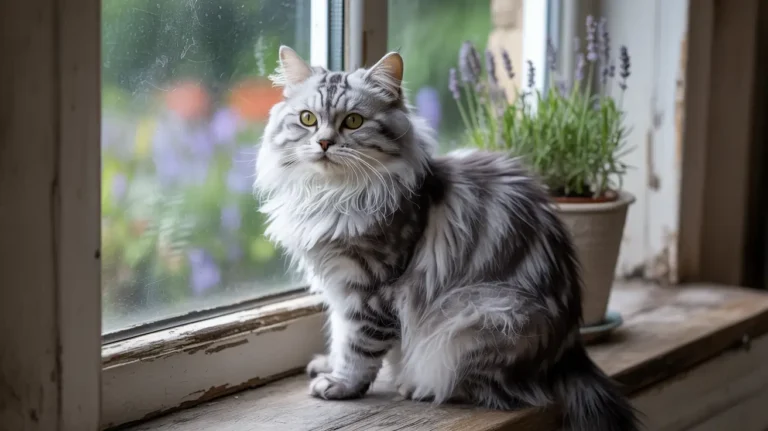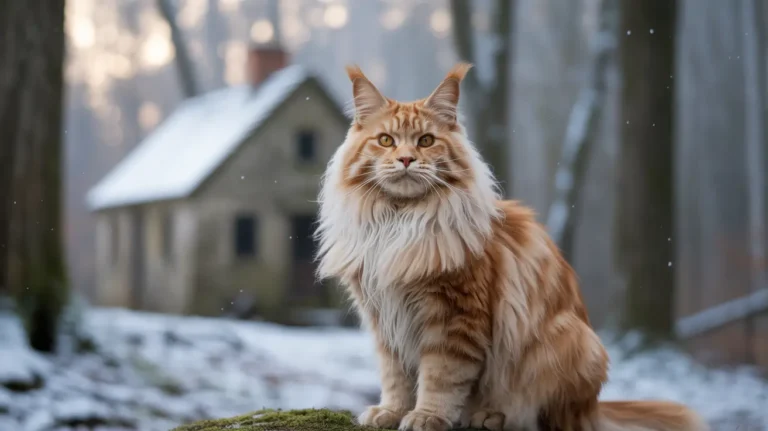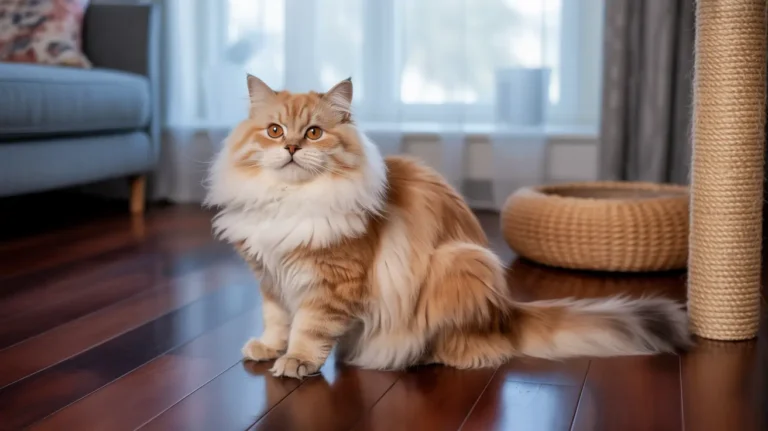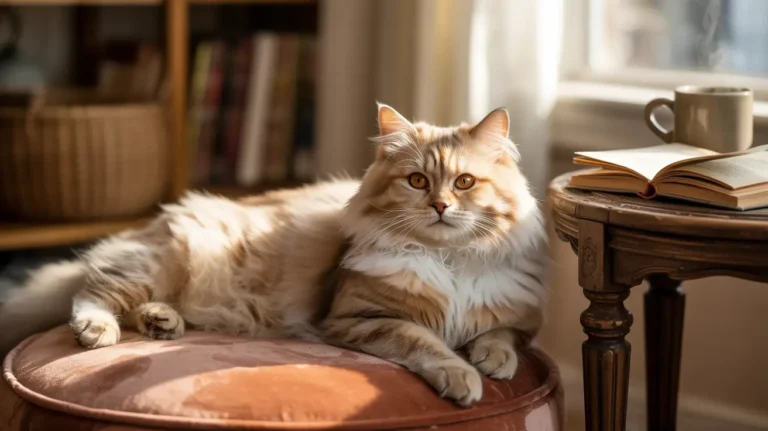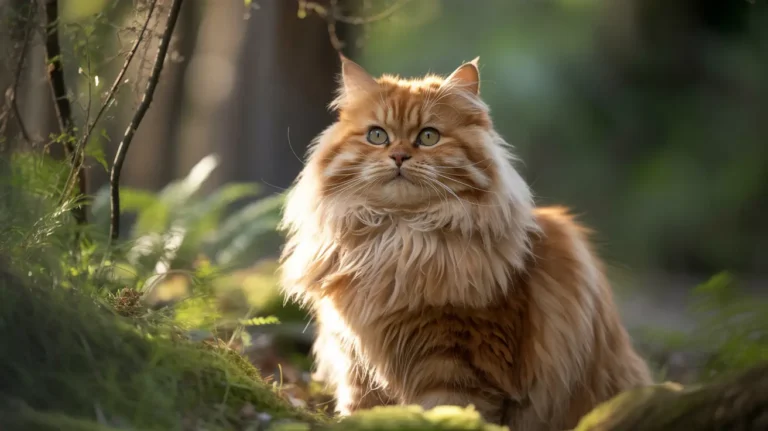Grooming of Maine Coon Cat: Easy Guide to Healthy Fur
The Maine Coon is famous for its long, flowing coat that feels as luxurious as it looks. But keeping it that way isn’t just about appearances. Regular grooming is essential to keep their skin healthy and their coat free from painful mats or tangles.
Many owners don’t realize that grooming also affects a cat’s mood, comfort, and overall well-being. Without it, issues like hairballs, parasites, and infections can creep in unnoticed.
In this guide, I’ll walk you through everything you need to know to care for your Maine Coon’s coat like a pro—even if you’re a first-time cat parent.
Understanding the Maine Coon Coat
Maine Coons have a thick double coat that includes a soft, dense undercoat and a coarser, water-repellent topcoat. This unique texture protects them in cold climates but also means they’re more prone to tangling and mats.
Their fur tends to grow longer around the neck, chest, and tail. This gives them a majestic look but also adds to the grooming challenge. Understanding how their coat behaves seasonally and reacts to different environments is the first step in building a smart grooming routine.
Why Regular Grooming is Crucial?
Grooming your Maine Coon isn’t just about keeping them looking beautiful—it’s an essential part of their overall health and well-being. Without regular brushing, their thick double coat can easily develop mats, which pull at the skin and cause pain, discomfort, and even skin infections.
Routine grooming not only keeps their fur smooth and tangle-free, but also allows you to spot early signs of issues like parasites, dandruff, rashes, or unusual lumps. A well-groomed Maine Coon is typically more relaxed, active, and happy.
Plus, grooming sessions create valuable bonding time, helping your cat feel safe, secure, and loved in your care.
Want to Nail the Grooming of Maine Coon Cat? Here’s How!
Grooming of your Maine Coon cat doesn’t have to be hard or stressful. With the right tips and tools, you can easily keep their thick, beautiful coat healthy and mat-free. Regular grooming helps prevent painful tangles, reduces shedding, and keeps your cat comfortable.
Start by brushing your cat every few days, increasing frequency during shedding season. Use a slicker brush and wide-tooth comb to reach those tricky spots like under the legs and behind the ears. Remember, gentle strokes and patience are key—make grooming a calm, positive time with treats and praise.
By understanding your Maine Coon’s specific coat needs and staying consistent, you’ll not only improve their coat health but also strengthen the bond you share. Ready to become your cat’s favorite groomer? Let’s get started!
How Often Should You Groom a Maine Coon?
Maine Coons have a thick, luxurious coat that demands regular grooming—not just for beauty, but for their comfort and health. Since they can’t always manage their heavy fur on their own, it’s important for owners to maintain a consistent grooming routine based on the cat’s lifestyle, age, and the season.
Regular Brushing Schedule
Brushing every 2 to 3 days is usually enough for most Maine Coons. This prevents tangles and keeps their coat looking fresh and healthy.
More Brushing During Shedding Seasons
In spring and fall, when shedding increases, switch to daily grooming to control loose hair and avoid matting.
Adjusting for Activity and Age
Outdoor and very active cats may need more frequent grooming due to exposure to dirt. Older or sick cats also benefit from extra help since they may not groom themselves efficiently.
Watch for Signs
If you notice mats, hairballs, or excessive shedding, it’s a sign to groom more often.
Tools You Need for Effective Grooming
Grooming a Maine Coon properly isn’t just about brushing—it’s about using the right tools for different coat needs. Since their double coat is prone to tangles, mats, and shedding, having the proper equipment makes the process easier, faster, and more comfortable for both of you.
Slicker Brush for Surface Grooming
A slicker brush is perfect for regular brushing sessions. It helps remove surface debris and loose fur while smoothing the topcoat.
Wide-Tooth Comb for Undercoat Care
This tool is essential for reaching deep into the thick undercoat where tangles often hide, especially around the belly, armpits, and neck.
Deshedding Tool for Seasonal Use
During high-shedding periods, a deshedding tool like the Furminator removes undercoat hair efficiently, reducing shedding and hairballs.
Step-by-Step Brushing Routine
Brushing your Maine Coon the right way helps maintain coat health and builds trust between you and your cat. A calm, consistent routine makes the experience easier over time—even for nervous or energetic cats.
Prepare the Environment First
Start grooming in a quiet, relaxed area where your cat feels safe. Let your cat sniff the brush or comb before you begin. Offer treats to create a positive association.
Brush Gently in the Right Direction
Always brush in the direction of hair growth, beginning at the head and moving toward the tail. Use short, smooth strokes. Pay extra attention to delicate areas like the belly, legs, and tail. Don’t forget common mat zones—behind the ears, under the arms, and around the neck.
Take breaks if your cat shows signs of stress. Consistency, patience, and positive reinforcement are key to turning brushing into an enjoyable bonding routine for both of you.
Bathing Your Maine Coon (Yes or No?)
Most Maine Coons do not need frequent baths, thanks to their self-cleaning habits and water-resistant coats. However, certain conditions may require occasional washing.
When Bathing Is Necessary
Bathing can help if your cat suffers from skin allergies, has fleas, or gets into something sticky or harmful. Long fur can trap dirt, so a rare bath is acceptable when truly needed.
How to Bathe Safely
Use lukewarm water and only cat-safe, hypoallergenic shampoo. Never use human shampoos—they can cause skin irritation. After rinsing, gently towel-dry your cat.
A low-noise hairdryer on a cool setting may help, but only if your cat tolerates it. Always ensure your Maine Coon stays warm and stress-free during and after the bath. If your cat resists bathing strongly, consider professional grooming services.
Grooming for Shedding Season
During spring and fall, Maine Coons go through a natural shedding cycle, losing large amounts of fur. This seasonal transition calls for an adjusted grooming approach to keep your cat comfortable and your home hair-free.
Increase Brushing Frequency
Brush daily during shedding seasons to remove loose undercoat fur. This prevents mats and reduces hairballs, which can lead to digestive issues. A deshedding tool like the Furminator can be very effective.
Support with Diet & Supplements
Omega-3 and Omega-6 fatty acids, found in high-quality cat food or supplements, can improve coat strength and reduce excessive shedding. Hydration also plays a role—always provide fresh water.
Keep grooming sessions short, positive, and consistent to avoid overwhelming your cat during this already sensitive time.
Grooming Older or Anxious Maine Coons
Older Maine Coons or anxious cats need special care during grooming. Age-related stiffness or anxiety can make grooming challenging, so it’s important to adjust your approach accordingly.
Special Care for Senior Cats
Older cats may experience arthritis, making brushing painful if done too harshly. Use soft-bristled brushes and groom slowly, focusing on comfort over perfection. Groom them while they lie in a cozy position.
Helping Anxious Cats Relax
For nervous cats, start with short grooming sessions and offer treats as rewards. Speak gently and keep movements slow. If your cat continues to resist, consult a feline behaviorist or a professional groomer experienced in handling sensitive cats.
Dealing with Mats and Tangles
Due to their long, thick fur, Maine Coons are prone to developing mats, especially in hard-to-reach areas. Ignoring them can lead to discomfort or even skin infections, so early action is best.
Removing Mild Mats Safely
Start with your fingers to gently pull apart small mats. A cat-safe detangling spray can soften the fur. Use a wide-tooth comb to work through the knots without pulling too hard.
When to Use Scissors or Get Help
If the mat is large or tight, use grooming scissors with rounded tips very carefully, or better yet, let a professional groomer handle it. Never cut too close to the skin—it’s easy to cause injury. Regular grooming is the best way to avoid mats altogether.
Skin and Coat Health from the Inside Out
Your Maine Coon’s grooming isn’t just about brushing—it also depends on what goes into their body. A healthy coat reflects a well-balanced, nutrient-rich diet and proper hydration. Supporting their health from the inside ensures a softer, shinier coat and less shedding overall.
Choose Nutrient-Rich Cat Food
Opt for high-protein cat food made with real meat as the first ingredient. Look for formulas that include omega-3 and omega-6 fatty acids, which promote healthy skin and reduce inflammation. These nutrients help keep the coat glossy, reduce itching, and prevent dandruff.
Hydration and Supplements Matter
Always provide clean, fresh water to keep your cat well-hydrated—dehydration leads to dry, brittle fur. Some cats may benefit from skin and coat supplements, but only use them under your vet’s guidance. A good internal health routine minimizes excessive shedding and helps prevent skin problems like dryness, flakiness, or irritation.
Signs It’s Time to Call a Groomer or Vet
Sometimes, home grooming isn’t enough—especially when serious coat or skin issues appear. Knowing when to seek professional help can prevent discomfort and more serious health problems for your Maine Coon.
If your cat has mats that are too tight or painful to remove, visible bald spots, constant itching, or signs of skin infections (like redness or scabs), it’s best to consult a professional. A certified groomer can gently handle heavy matting or give a full grooming session without stressing your cat.
Meanwhile, a veterinarian can identify medical causes like allergies, parasites, or fungal infections that may be affecting the coat. Never try to forcefully remove large mats at home, as this can damage the skin. Instead, choose professionals who have experience with long-haired breeds like the Maine Coon.
They’ll know how to groom safely and gently. Regular visits to a vet or groomer can complement your grooming routine and help keep your cat’s coat and skin in excellent condition.
How to Make Grooming Enjoyable for Your Maine Coon
Establishing a regular grooming routine helps your Maine Coon feel safe and relaxed. With patience and consistency, even nervous cats can learn to enjoy grooming.
Start by picking a specific time each day or week—routine builds trust. Keep early sessions short (5–10 minutes) and always be gentle. Use a soft voice and calm energy to help your cat feel at ease. Gradually increase grooming time as your cat gets more comfortable.
Offer rewards like treats or extra cuddle time to positively reinforce the experience. If your cat becomes agitated, pause the session and try again later—never force it. Over time, grooming can become a bonding activity that strengthens your relationship.
Consistency is key: brushing every 2–3 days prevents mats and reduces hairballs. The more regular the routine, the less stressful grooming becomes. Eventually, your Maine Coon may look forward to grooming time as a moment of comfort and connection with you.

